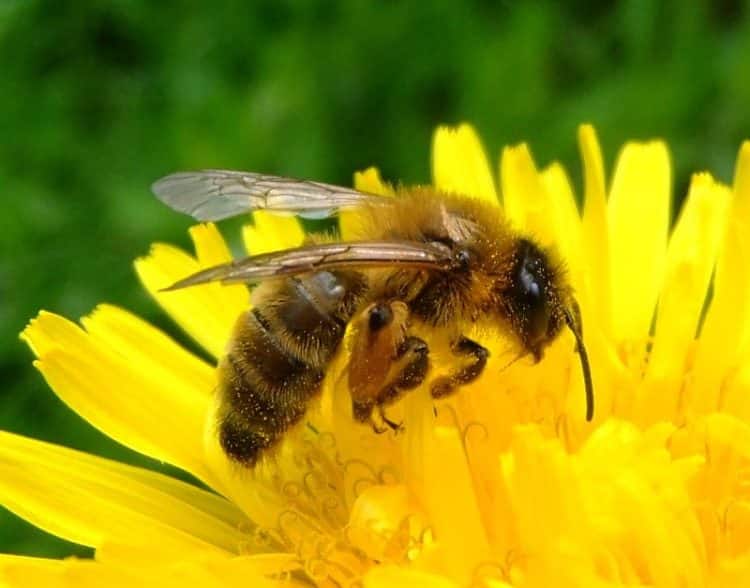Honey isn’t the only valuable product produced by bees. Propolis is a substance created by honeybees with “antioxidant, anti-inflammatory, anticancer, and antimicrobial effects.” [1] The bees use propolis as a sort of natural sealant, while pharmaceutical companies and manufacturers are interested in its bioactive properties.
In its raw form, propolis is a sticky mixture of plant resin, pollen, beeswax; organic compounds include polyphenols, terpenes, amino acids, and sugars. The exact makeup varies based on the bees’ genetic information and environment. When propolis is harvested for human use, the beekeepers’ practices affect the quality of the final product.
A recent study [1] examined the effects of individual compounds contained in propolis and compared them with the effects of whole propolis. Specifically, the researchers looked at polyphenols, compounds that are known for their antioxidant and anti-inflammatory qualities. [2]
For instance, the flavone chrysin, a type of polyphenol often found in propolis, is reported to have “neuroprotective, nephroprotective and cardioprotective” effects. [1] Caffeic acid phenethyl ester (CAPE) is a typical phenolic acid in propolis; the authors describe CAPE as a “potent antioxidant…with excellent anti-inflammatory, wound-healing, antidiabetic, organ protective, anticancer, and antimicrobial properties.” The flavonol galangin is another common constituent noted for antimicrobial and anticancer activities.
The review also covers extraction techniques for propolis, the most traditional being ethanol and water maceration (7-30 days) to create tinctures. Concentrations of 60-80% ethanol may be ideal to maximize antioxidant and antimicrobial outcomes. [3] Pure water may also be used, particularly when paired with high temperatures (50-95 ºC), Soxhlet extraction, or ultrasound-assisted extraction. 1,2-Propylene glycol (1,2-PG) has been shown to be an effective organic solvent conferring high polyphenol yields in propolis extracts. [4] Contemporary (and effective) green methods include deep eutectic solvents, supercritical carbon dioxide (CO2), and Ohmic heating in a vacuum.
On this last method, researchers [5] designed a system using either water or 70% ethanol with water; they applied electric current (100 V for water and 220 V for ethanol/water) under vacuum (16.6 kPa) at 58ºC (water) or 37ºC (ethanol/water). Both techniques quintupled flavonoid content of extracts compared to conventional maceration.
The research team found that propolis’ protective qualities were apparent regardless of its exact chemical makeup. “Interestingly,” they note, “although propolis content varies depending on extraction, it seems like different extract’s [sic] biological activities remain comparable.” However, the industry should continue to focus on improved extraction methods, as it’s suspected that propolis’ beneficial compounds work synergistically. Standardization could help pharmaceutical development.
“Pharmacological effects of propolis extracts are very similar to the effects of their bioactive molecules’ [sic], although they result from the interaction between them,” the researchers concluded.
Image source: Orangeaurochs, Flickr, CC BY 2.0
References:
1- Šuran J, et al. Propolis extract and its bioactive compounds—from traditional to modern extraction technologies. Molecules. 2021;26(10):2930. https://doi.org/10.3390/molecules26102930. [Impact Factor: 4.411; Times Cited: 2 (Semantic Scholar)]
2- Liu L, et al. Protective effects of tea polyphenols on exhaustive exercise-induced fatigue, inflammation and tissue damage. Food & Nutrition Research. 2017;61(1) 1333390. 1 Jun. 2017, doi:10.1080/16546628.2017.1333390. [Impact Factor: 3.89; Times Cited: 17 (Semantic Scholar)]
3- Park YK, Ikegaki M. Preparation of water and ethanolic extracts of propolis and evaluation of the preparations. Biosci Biotechnol Biochem. 1998;62:2230–2232. [Impact Factor: 1.916; Times Cited: 82 (Semantic Scholar)]
4- Ramanauskien K, et al. Total phenolic content and antimicrobial activity of different Lithuanian propolis solution. Evid Based Complement Altern Med. 2013(2013):1–5. [Impact Factor: 2.064; Times Cited: 25 (Semantic Scholar)]
5- Lastriyanto A, Kartika AA. Innovation of propolis extraction machine based on vacuum resistive heating. J Phys Conf Ser. 2020;1665:012012. [Impact Factor: 0.547; Times Cited: 1 (Semantic Scholar)]











